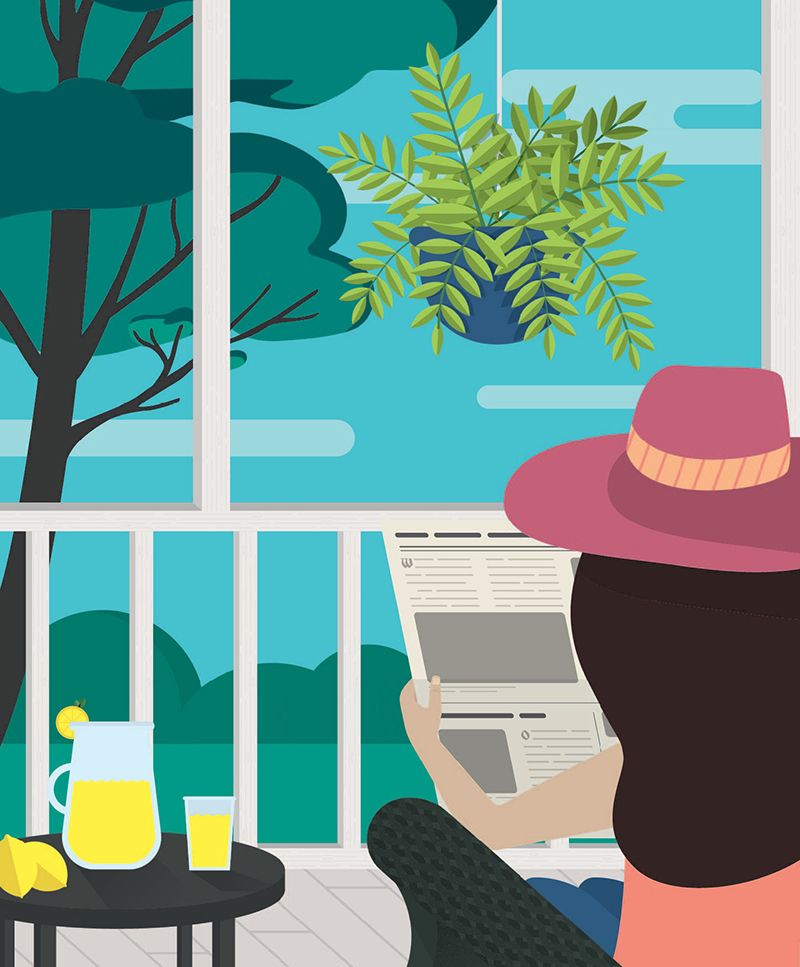A perch for pondering life lessons and time well spent

The rocker has a generous, wide berth, perfect for slumping low with the Sunday New York Times. The matching sofa is deep-seated and comfy, too. These old wicker pieces were Craigslist finds, and the moment I walked into the small North Charleston basement where they were paired up, dusty and decked out in flouncy floral fabric, I knew I’d found my porch furniture. Now lacquered in a chipping Charleston green and outfitted in bulletproof Sunbrella white, they are the best $75 I ever spent. Well, not counting the money spent building the porch.
Our front porch addition, now nearly five years weathered, has transformed our home. It has softened a quirky “V”-shaped angle, where the house hinges at the front door, and made it look slightly more Southern classic than raised-ranch weird. And it’s changed how we come and go, how we spend fall evenings and weekend mornings, and how I think about big expenditures, such as the money I used from my mother’s estate.
Unlike my friend Becca, who took the $7,500 she inherited after her mom died to turn an abandoned schoolhouse in Ecuador into Escuela Anne Stevens (named after her mother) to provide poor children with air-conditioned, high-tech classrooms, I was building a porch. As I sweated over architectural plans and construction estimates, I was haunted by Becca’s comment after visiting the kids wearing “Escuela Anne Stevens” shirts: “It was so clear to me that this is exactly what I was meant to do with that money,” she said. I, while being far less philanthropic, was also far less clear.
My mom, like Becca’s, had been a scrappy single mother—mine was divorced with three girls and unreliable child support; Becca’s widowed after her husband was killed by a drunk driver, leaving five children. My mom parlayed her good eye and excellent taste into a career of making people’s lives more beautiful. First she worked in a plant shop, selling fuzzy-leafed African violets and ferns; then in a high-end dress shop; and finally she sold furniture, helping people decorate their homes, and probably their porches. She worked on commission and managed her finances with scrupulous anxiety. To take the residual of her hard-earned life and put it toward an unnecessary expense felt frivolous. Building a porch made me scrupulously anxious.
But I did it anyway. And now, as September mornings yawn with amber light, I drink coffee on our porch, sipping the breeze. I sweep crape myrtle leaves from the floor and water the ferns and the fiddle-leaf fig—plants like the ones my mother once sold. I rock in the rocker, watch pelicans glide by, and tame my mind into not doing much of anything.
A front porch, I’ve found, is the ultimate luxury. It’s where sandals come off and feet go up. Where overhead fans whir and lemonade gets spiked and ice melts but you don’t mind, because the sun is melting over the horizon as well, and quiet confidences and stories begin to spill out into the evening air like cricket song.
A porch is for idling, for curling up on old wicker and listening for conversation crumbs from passersby. It is the spot for surveying bushes that need trimming and deciding, nah, not now. It is the in-between place—the bridge between the hot sun and the A/C, a truce between the chores and routines out in the world and those of the domestic variety. And it’s where I, in my middle age, am too. In between who I was as my mother’s daughter and as my daughters’ mother and who I might become in my mature years. And so I have spent my inheritance on an extravagant perch for ferns, wicker, and pondering.
It’s not an Ecuadorian schoolhouse, but this porch does offer lessons in living. Lessons learned in part from our neighbors, who held porch hours every afternoon when the husband had end-stage cancer. He sat in his rocker, his wife in the swing, as friends dropped by. There, they celebrated friendships, shared laughs and probably tears, drank wine, and pulled out folding chairs when more people showed up.
They spent on their porch extravagantly—nothing skimped, nothing saved. It was all poured out: open-air hospitality, open-armed life, open-to-death laughing and loving and remembering. This I celebrate in the drifty evening breeze on the porch I inherited from my mother—the laughter, the loving.